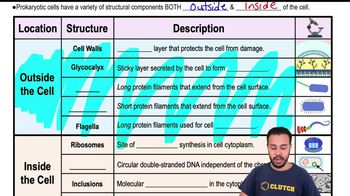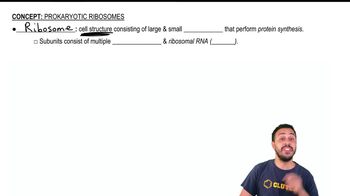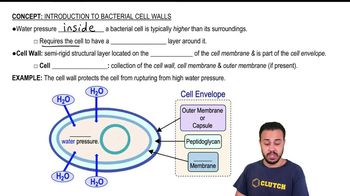DRAW IT What group of microbes is characterized by cells that form filaments, reproduce by spores, and have peptidoglycan in their cell walls?
 Tortora 14th Edition
Tortora 14th Edition Ch. 4 - Functional Anatomy of Prokaryotic and Eukaryotic Cells
Ch. 4 - Functional Anatomy of Prokaryotic and Eukaryotic Cells Problem 4.2a
Problem 4.2aWhich of the following is not a distinguishing characteristic of prokaryotic cells?
a. They usually have a single, circular chromosome.
b. They have 70S ribosomes.
c. They have cell walls containing peptidoglycan.
d. Their DNA is not associated with histones.
e. They lack a plasma membrane.
 Verified step by step guidance
Verified step by step guidance
Verified Solution
Key Concepts
Prokaryotic Cell Structure

Ribosome Composition

Cell Wall Composition

The antibiotic amphotericin B disrupts plasma membranes by combining with sterols; it will affect all of the following cells except
a. animal cells.
b. gram-negative bacterial cells.
c. fungal cells.
d. Mycoplasma cells.
e. plant cells.
Endospore formation is called (a) ________. It is initiated by (b) ________. Formation of a new cell from an endospore is called (c) ________. This process is triggered by (d) ________.
Use the following choices to answer questions 2–4.
a. No change will result; the solution is isotonic.
b. Water will move into the cell.
c. Water will move out of the cell.
d. The cell will undergo osmotic lysis.
e. Sucrose will move into the cell from an area of higher concentration to one of lower concentration.
Which statement best describes what happens when a gram-positive bacterium is placed in distilled water and penicillin?
DRAW IT Draw the bacterial shapes listed in (a), (b), and (c). Then draw the shapes in (d), (e), and (f), showing how they are special conditions of a, b, and c, respectively.
a. spiral
b. bacillus
c. coccus
d. spirochetes
e. staphylococci
f. streptobacilli
Use the following choices to answer questions 2–4.
a. No change will result; the solution is isotonic.
b. Water will move into the cell.
c. Water will move out of the cell.
d. The cell will undergo osmotic lysis.
e. Sucrose will move into the cell from an area of higher concentration to one of lower concentration.
Which statement best describes what happens when a gram-negative bacterium is placed in distilled water and penicillin?